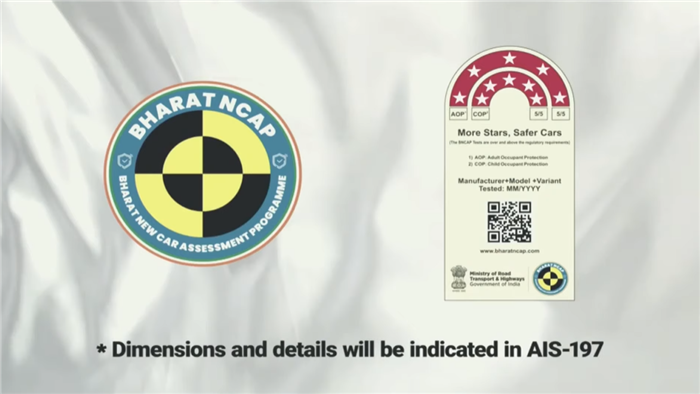Gadkari also said that the cost of testing a car under the Bharat NCAP programme is around Rs 60 lakh, whereas a similar test would require around Rs 2.5 crore if done overseas.
Also present at the event was David Ward, executive director for Global NCAP and President of the Towards Zero Foundation (TZF), who said that in the last decade, India was the most improved country among the G20 countries in terms of implementation of automotive safety systems. This is also significant given that the G20 accounts for over 80 percent of cars sold.
Bharat NCAP: ratings and tests
On a broad level, Bharat NCAP is aligned with global testing protocols, and speaking at the event, Anurag Jain, secretary, Ministry of Road Transport and Highways, said that with this the Indian automotive industry will also be more export-oriented.
The programme will award a star rating between 1-5 for cars tested, with 1 being the lowest. The evaluation will cover three areas: Adult Occupant Protection (AOP), Child Occupant Protection (COP) and Fitment of Safety Assist Technologies.
Three tests will be conducted as below:
- frontal impact test
- side impact test
- side pole impact test
Based on the performance of the vehicle in the tests, the model will be awarded a separate star rating for adult occupants (AOP) and child occupants (COP).
The front impact test will be against an offset deformable barrier at a speed of 64kph, which is the same as the Global NCAP protocol. All vehicles also need to meet the pedestrian protection norms and the pole impact test will only be carried out for cars securing 3 stars and above at a speed of 29kph.
Additionally for any car to carry a 3 or higher star rating, it must also have electronic stability control and front seat belt reminders fitted. Seat belt reminders are a good addition to the protocol, however, given their low cost and ease of implementation, this should have been included for all seats.
| Bharat NCAP star rating | ||
|---|---|---|
| Rating | Adult occupant (AOP) | Child occupant (COP) |
| 5-star | 27-32 points | 41-49 points |
| 4-star | 22-26 points | 35-40 points |
| 3-star | 16-21 points | 27-34 points |
| 2-star | 10-15 points | 18-26 points |
| 1-star | 4-9 points | 9-17 points |
The maximum score for adult occupants (AOP) is 32 points and for child occupants (COP) is 49 points.
Bharat NCAP: which vehicles qualify?
The Bharat NCAP crash test programme is based on the Automotive Industry Standard AIS 197. Vehicles falling under the M1 category that have been approved for carrying up to eight passengers, in addition to the driver; have a gross weight lower than 3.5 tonnes; and are either manufactured or imported into the country will be eligible for the Bharat NCAP crash tests. Apart from combustion-engined vehicles sold in India, the Bharat NCAP programme will also test and rate CNG and electric vehicles.
Bharat NCAP: how does it work?
The car manufacturer nominates a vehicle model.
The Bharat NCAP team will visit the manufacturing facility of that particular vehicle and will select the base variant through random sampling.
The selected vehicle will then be dispatched to the Bharat NCAP testing centre by the manufacturer.
The selected vehicle will be crash tested and the process will be witnessed by representatives of the car manufacturer and the Bharat NCAP team.
Test results will be compiled and shared with the car manufacturer followed by the Bharat NCAP standing committee approval.
After the standing committee's approval, the star ratings and crash test results of that particular vehicle will be published by Bharat NCAP and the certificate will be issued by the Central Institute of Road Transport (CIRT).




Comments
Member Login
Personal Details
No comments yet. Be the first to comment.